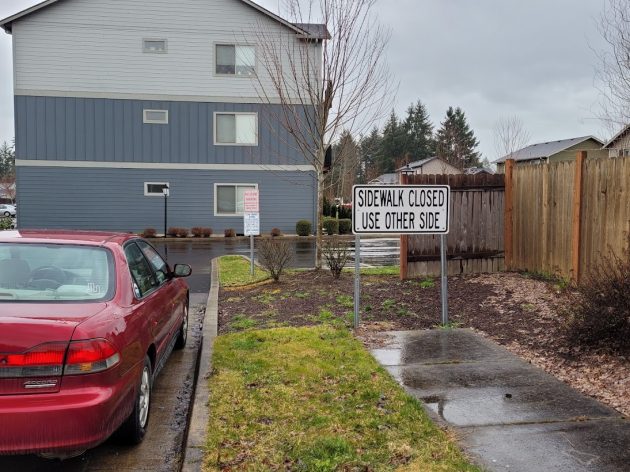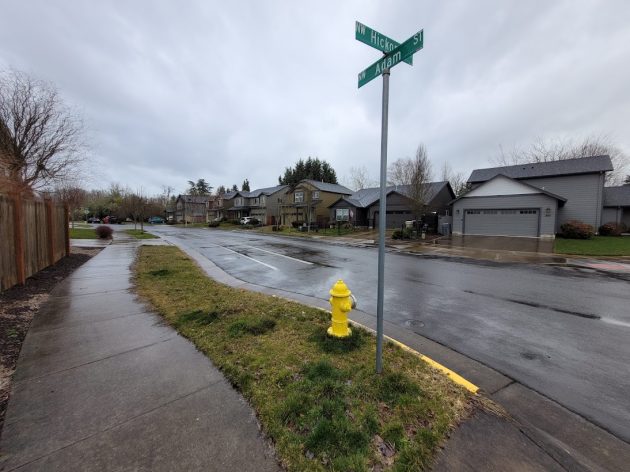
That sign to the contrary not withstanding, this actually is close to a “walkable neighborhood.” It’s near North Albany Village.
Albany and other towns of similar size are under state orders to do something that’s impossible: to create “climate friendly areas” where people in the future won’t need cars to go to work or meet most other needs.
A public meeting to discuss it is scheduled at 6 p.m. Tuesday in the council chambers at City Hall.
Officials are telling people these areas have to be developed to meet the state government’s “climate goals.” If that’s what it takes, though, the climate goals will not be met. Because such areas can’t be created without a complete restructuring of how our economy works.
Consider what’s happened so far. Without invoking the climate, Albany has been trying to promote the idea of walkable neighborhoods for a long time. And are there any? Not yet.
Ideally, such a neighborhood would be one where to get to your job, you can walk or take a bike, or wait for a bus at a stop within a few minutes of your front door. And a bus would come every few minutes too.
In the historic districts, if you’re able you can walk downtown to visit a restaurant, bank, or local government office. But even there the lack of a market kills walkability.
And as for jobs, forget it, at least for people who must to show up at a job site. The jobs are mostly far away, or even in other towns.
Some 20 or more years ago, Albany tried to rezone parts of town to establish “village centers.” The first to be created was North Albany Village, the commercial center at Hickory Street and North Albany Road.
There, the idea of a walkable neighborhood is at least theoretically possible. Single-family housing and apartments have sprung up within 10 or 15 minutes’ walk. And in or near the center, possible destinations include a hardware store, supermarket, pharmacy, liquor store, two banks, several restaurants, numerous medical clinics and a couple of dental offices, other professional offices from real estate to insurance and veterinary care, a hair salon, and shops offering clothing and gifts, hearing aids, and eye care. There’s even a post office.
So if you live nearby and don’t have to commute to work, you might be able to go for weeks without having to drive anywhere. But even there, people still drive where they need or want to go.
And in the sections of Albany where most new housing is being built, including hundreds of new single-family dwellings in the south along Columbus Street and Lockner Road, and in the northeast corner east of I-5, it’s going to be tough to run an errand without driving.
City officials can talk about walkability or climate-friendly neighborhoods as a goal, but they have no power or ability to put services, industrial plants and residents close enough together for everyday errands to be accomplished on foot. (hh)

These homes at Adam and Hickory are within walking distance of some services, if you like walking in the rain.



State orders are not needed in a free country. Oregon citizens should vote on an constitutional amendment to severely reduce the power of the state government, at least to get rid of such unfunded mandates.
If the current state of humanity is as Hering describes, then there is little hope, indeed. Hering’s broad, cynical brush paints a chilling Neo-Abstract image frozen in time and space…a state of being where change is impossible and the eternal status quo is our fate.
The difference between those who remain intensely loyal to whatever’s currently in vogue and those who imagine something else isn’t just a game of clashing parties and competing interests. “The right reason is to challenge the status quo, to serve the common good, and to leave this nation better than we found it. “. The quoted words were uttered by Sara Palin, a woman who has never been accused of progressive thinking. Perhaps the Reactionary Right should pay heed to Palin’s wisdom on this topic.
It would be wonderful if dementia Joe would heed Palin’s words.
Even a dim bulb can shine bright, really bright just before it flames out.
Maybe there is a chance for Biden because he is definitely a dim bulb.
The “future” presented as a goal existed in my childhood.
Cars were a novelty, not a necessity. Within walking distance were two groceries, a dry cleaner, two shoe repair shops, two drug stores, and public transport that stopped every 15 minutes.
Public transport was electric — trolley-buses, trolley-cars, and the subway/el.
Seems that making cars a necessity was a goal. Down came the unsightly overhead wires. Up came the ugly tracks. Along came supermarkets and shopping centers. The small businesses on the corners disappeared.
I frankly don’t see that a great leap backward can be successful
I expect from this quarter an acknowledgment of how much useful transport can be accomplished by bicycle; indeed, active transportation in all kinds of weather is, or should be, a hallmark of Oregonians.
Comfort, convenience and cheap gasoline are shameful responses to the real need for better-connected neighborhoods and stronger local economies.
I’m hoping hh will report all the machinations the Council goes thru tonite by poking fun at the impossible goal
The proposed project is a necessity for a much larger city that has squeezed its populations into overcrowded areas or pushed them out of areas due to heavy concentrations of businesses. Albany does not have population to support this overestimated need. You can already ride your bike anywhere in the city in 15 minutes or less. Is Albany planning to grow up to be Portland? Albany needs a lot TLC in our community that already exists. Give some help to people struggling to keep their homes and local businesses, repair our streets and improve what we do have.
Progressive goals are not always about modernizing life. It is about increasing everyone’s quality of life.